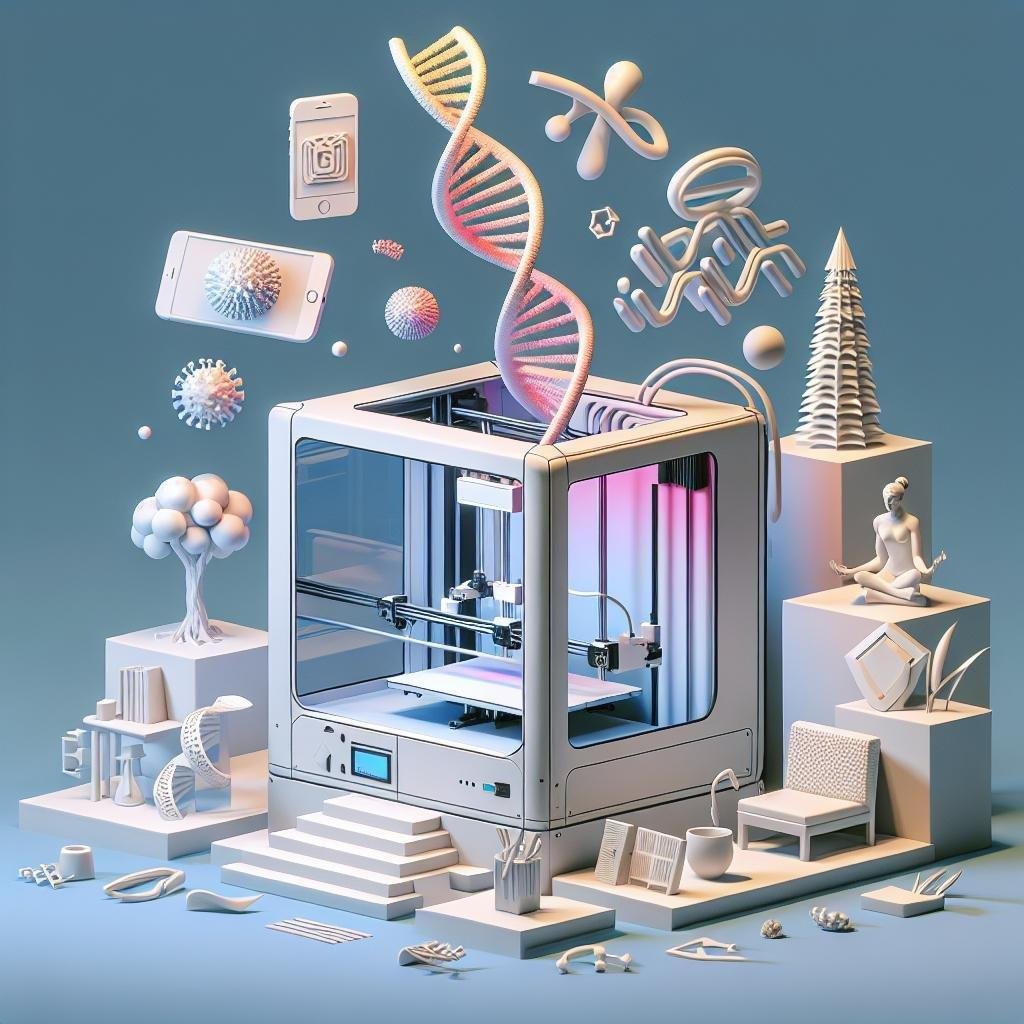With a sense of wonder that’s reminiscent of science fiction tales, the world of 3D printing continues to reshape our imagination into tangible reality. From intricate architectural models to life-saving medical devices, this transformative technology is evolving at breakneck speed, each breakthrough more dazzling than the last. Whether you’re a tech aficionado, an industry professional, or simply a curious explorer, join us on this fascinating journey as we delve into the latest and most exhilarating innovations in 3D printing. Discover how far we’ve come, where we’re headed, and the mind-blowing possibilities that await just around the corner. Buckle up, friends—this is a voyage you won’t want to miss!
Revolutionizing Healthcare: 3D Printing’s Impact on Medical Advancements
From custom prosthetics to bioprinting tissues, the integration of 3D printing in the medical field is transforming patient care in unprecedented ways. **Custom prosthetics** tailored to the unique contours of individual patients are more comfortable and functional than ever before, enhancing the quality of life for countless individuals. Moreover, **surgical tools** created with 3D printing technology allow for precise customization, which can result in more successful outcomes and reduce the risk of complications during procedures.
In the realm of bioprinting, researchers are making incredible strides. **3D-printed tissues and organs** are no longer the stuff of science fiction but are rapidly approaching reality. Imagine a future where organ transplant waitlists are a thing of the past, thanks to organs being printed on-demand using a patient’s own cells. This innovation not only addresses the shortage of donor organs but also significantly lowers the risk of organ rejection. Explore this exciting field further with some of the latest advancements:
| Advancement | Description |
|---|---|
| Bioprinted Skin Grafts | Customized skin grafts that minimize scarring and accelerate healing. |
| 3D-Printed Kidney Tissues | Promising developments in recreating functional kidney tissues for researchers. |
| Personalized Implants | Tailor-made implants designed to fit individual patient anatomies perfectly. |

Eco-Friendly Filaments: Sustainable Materials for a Greener Tomorrow
In the realm of 3D printing, a revolutionary shift is happening with the advent of eco-friendly filaments that promise not just innovation, but a commitment to sustainability. These sustainable materials are crafted from biodegradable sources, including PLA derived from corn starch and PHA from microbial fermentation. By choosing these environmentally responsible options, creators reduce waste and support a circular economy. Additionally, recycled filaments made from post-consumer plastics are gaining popularity, meaning your next 3D printed project could quite literally be saving sea turtles or reducing landfill burdens.
The benefits of these green materials go beyond just the environmental impact. Designers and engineers are discovering that eco-friendly filaments offer unique characteristics that enhance their work:
- PLA (Polylactic Acid): A popular choice for its ease of use, vibrant colors, and stiffness, making it ideal for prototypes and educational projects.
- PETG (Polyethylene Terephthalate Glycol): Combining ease of use with durability and resistance to moisture, this filament bridges the gap between PLA and ABS.
- Recycled Filaments: These maintain high-quality print features while incorporating sustainable practices by reusing materials that would otherwise end up in landfills.
| Filament Type | Main Component | Key Benefits |
|---|---|---|
| PLA | Corn Starch | Biodegradable, Easy to print |
| PETG | Glycol-Modified Plastic | Durable, Moisture Resistant |
| Recycled Filament | Post-Consumer Plastic | Sustainable, High-Quality |
Embracing these eco-friendly filaments not only signifies a leap towards greener manufacturing practices but also sparks creativity with new material properties to explore. They represent a viable and exciting step forward in marrying technological progress with conscientious environmental stewardship.

From Prototypes to Final Products: Speed and Precision in Modern Manufacturing
Transformative advancements in 3D printing technology are revolutionizing the way we create and produce items with unparalleled **speed and precision**. Today’s cutting-edge printers are capable of utilizing diverse materials such as metals, biocompatible substances, and ceramics, moving beyond the traditional plastics. The advent of **multi-material printing** empowers manufacturers to fabricate complex, layered structures that meet specific needs in aerospace, healthcare, and consumer goods. Imagine prosthetics that are not only functional but also tailored to the individual’s anatomy, or automotive parts that are produced in a fraction of the time while maintaining optimal strength and durability.
- Enhanced material versatility
- Rapid prototyping and production
- Complex component manufacturing
- Customized solutions for various industries
| Feature | Benefit |
|---|---|
| Multi-material Printing | Allows simultaneous use of different materials |
| High-Speed Production | Drastically reduced lead times |
| Precision Engineering | Greater accuracy and detail in end products |
Moreover, the integration of **AI-driven design algorithms** is making it possible to fine-tune configurations and predict potential issues before the item even hits the manufacturing phase. This not only saves time but also minimizes waste, embodying the essence of eco-friendly production. Industries can now capitalize on **digital twin technology**, where exact virtual replicas of physical products are used to simulate and validate processes, ensuring that prototypes transition seamlessly into final products.

Pushing Boundaries: The Future of Multi-Material 3D Printing
In recent years, the universe of 3D printing has taken a quantum leap with the introduction of multi-materials. Imagine a single object seamlessly integrating various **textures, strengths, and properties**—such as a soft-touch handle on a sturdy tool or a medical model showcasing both bone and soft tissue. This isn’t science fiction; it’s the emerging reality enabled by multi-material 3D printing. The industry is buzzing with excitement as this advancement pushes the boundaries of innovation, creating new potentials for **designers and engineers** alike. Key benefits include:
- Enhanced product functionality
- Reduced need for post-processing
- Increased customization options
To really appreciate the capabilities of multi-material 3D printing, let’s look at some practical applications already making waves:
| Application | Benefit |
|---|---|
| Prototyping | Fast, cost-effective iterations |
| Wearable Tech | Comfortable, ergonomic designs |
| Medical Modeling | Highly accurate, functional models |
By integrating multiple materials into a single print, designers can experiment with new forms and functions, creating innovative solutions that were once thought impossible. Clearly, as the technology matures, the only real limitation lies in our imagination.
Q&A
Q&A: Innovations in 3D Printing: What’s New and Exciting
Q: What’s the buzz about 3D printing lately?
A: Oh, where do we even start? 3D printing has evolved from a niche hobby to a mainstream marvel! People are no longer just printing miniatures and gadgets. They’re now creating entire houses, custom footwear, and even sophisticated medical implants. Imagine walking through a neighborhood with 3D-printed houses — it’s like something out of a sci-fi movie!
Q: Wow, that sounds incredible! What’s the most exciting new development in 3D printing?
A: Hands down, it has to be bioprinting. Scientists are now able to print human tissues and organs using cells. This isn’t just a leap; it’s a quantum leap. We’re talking about potentially ending the organ donor shortage, and being able to create tailored tissues for patients. The possibilities are boundless. Imagine custom-printed organs perfectly suited to your body!
Q: How about the materials used for 3D printing? Any cool updates there?
A: Absolutely! The range of materials has skyrocketed. We’re no longer confined to just plastics. There are flexible filaments, metals, ceramics, and even food-grade materials! Picture printing your own personalized chocolate designs. It’s a sweet revolution, literally!
Q: Personalized chocolates sound delicious! What’s making this possible?
A: The magic lies in the advancement of multi-material printers. These bad boys can handle different materials simultaneously, paving the way for complex and versatile creations. This means you could, theoretically, print a pair of shoes with varied textures and strengths in a single print job. Personalized and exactly how you want them!
Q: Are there any new 3D printing techniques that are changing the game?
A: For sure! One technique that’s causing quite a stir is Continuous Liquid Interface Production (CLIP). It’s like something from the future; it uses a pool of resin and ultraviolet light to create objects rapidly, layer by layer, without the usual stepping. This results in smoother surfaces and faster production times. Think of it as the difference between a cranky old typewriter and the latest snazzy laptop.
Q: That’s impressive! What industries are benefiting the most from these innovations?
A: It’s a smorgasbord! Healthcare, aerospace, automotive, fashion, and even the culinary world are reaping the benefits. Medical professionals are printing prosthetics tailored to individual needs, while astronauts could one day print tools and parts on Mars. And in fashion, designers are crafting intricate and unique pieces that would be impossible by traditional methods. The sky isn’t the limit anymore – Mars might be!
Q: How accessible is all of this for the everyday person?
A: Amazingly accessible! Desktop 3D printers are now more affordable than ever, starting at just a couple of hundred dollars. There’s also a vibrant community with endless resources. From online tutorials to user forums, it’s never been easier to get started. Plus, makerspaces are popping up everywhere, giving people the chance to dive into 3D printing without having to invest in their own equipment.
Q: That’s awesome! Where do you see the future of 3D printing going?
A: The future looks bright and limitless. We’re talking about on-demand everything – tailored clothing, custom furniture, and even nutritional supplements designed specifically for your dietary needs. And with ongoing research, who knows? One day we might be printing entirely new life forms or constructing mega-structures. The horizon is boundless, and we’re just at the beginning of this incredible journey. Buckle up; it’s going to be a thrilling ride!
Q: Sounds like an exciting era! Any advice for someone looking to dive into the world of 3D printing?
A: Dive in! Start with small projects to get a feel for the process. Embrace the learning curve and don’t be afraid to experiment. Join a local or online community, share your creations, and learn from others. The world of 3D printing is vast and welcoming, and your next great idea could be just a print away. Happy printing!
Insights and Conclusions
As our journey through the dynamic world of 3D printing draws to a close, it’s clear that we’re standing on the brink of a revolution where imagination and innovation effortlessly fuse. From edible masterpieces to lifesaving medical marvels, the realm of 3D printing constantly evolves, breaking boundaries and redefining what’s possible.
So, whether you’re a fearless pioneer eager to dive into the next big project or an intrigued observer marveling at humanity’s ingenuity, one thing is certain: the future is being printed one layer at a time, and it’s more thrilling than ever. Stay curious, stay inspired, and keep an eye on the horizon—because in the universe of 3D printing, the next extraordinary breakthrough is always just a click away.
Happy printing!

